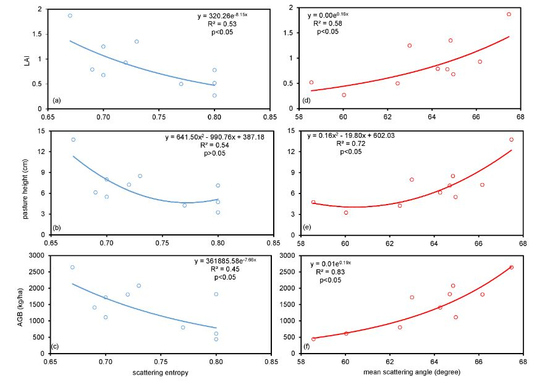A Preliminary Investigation of the Potential of Sentinel-1 Radar to Estimate Pasture Biomass in a Grazed Pasture Landscape
Abstract
1. Introduction
2. Materials and Methods
2.1. Description of Study Site and Selection of Sampling Sites
2.2. Field Data Collection and Processing
2.3. Theory of Eigenvector Scattering Mechanism
2.4. Pre-Processing of Sentinel-1 Data
2.5. Statistical Analysis
3. Results
3.1. Exploratory Analysis of Field Data
3.2. Spatial Characterisation of SAR Polarimetric Measures
3.3. Regression Analyses
3.3.1. Field Measured Biophysical Variables and Influence of Soil Moisture and Roughness on SAR
3.3.2. SAR Polarisation against Biophysical Variables
3.3.3. The Biophysical Variables against Polarimetric Scattering Parameters
3.4. Generalised Additive Model for AGB Estimation
4. Discussion
4.1. The Influence of Topography on SAR Measures
4.2. Relationship between the Biophysical Variables and Polarimetric SAR Parameters
4.3. Estimation of Pasture Grass AGB
5. Conclusions
Author Contributions
Funding
Acknowledgments
Conflicts of Interest
References
- Behrendt, K.; Cacho, O.; Scott, J.M.; Jones, R. Optimising pasture and grazing management decisions on the Cicerone Project farmlets over variable time horizons. Anim. Prod. Sci. 2013, 53, 796. [Google Scholar] [CrossRef]
- Gherardi, S.; Anderton, L.; Sneddon, J.; Oldham, C.; Mata, G. Pastures from space–the value to Australian sheep producers of satellite-based pasture information. In Proceedings of the 12th Australasian Remote Sensing and Photogrammetry Conference, Freemantle, WA, Australia, 18–22 October 2004. [Google Scholar]
- Hanrahan, L.; Geoghegan, A.; O’Donovan, M.; Griffith, V.; Ruelle, E.; Wallace, M.; Shalloo, L. PastureBase Ireland: A grassland decision support system and national database. Comput. Electron. Agric. 2017, 136, 193–201. [Google Scholar] [CrossRef]
- Andersson, K.; Trotter, M.; Robson, A.; Schneider, D.; Frizell, L.; Saint, A.; Lamb, D.; Blore, C. Estimating pasture biomass with active optical sensors. Adv. Anim. Biosci. 2017, 8, 754–757. [Google Scholar] [CrossRef]
- Schaefer, M.T.; Lamb, D.W. A combination of plant NDVI and LiDAR measurements improve the estimation of pasture biomass in tall fescue (Festuca arundinacea var. Fletcher). Remote Sens. 2016, 8, 109. [Google Scholar] [CrossRef]
- Trotter, M.; Lamb, D.; Donald, G.; Schneider, D. Evaluating an active optical sensor for quantifying and mapping green herbage mass and growth in a perennial grass pasture. Crop Pasture Sci. 2010, 61, 389–398. [Google Scholar] [CrossRef]
- Clarke, D.; Litherland, A.; Mata, G.; Burling-Claridge, R. Pasture Monitoring from Space. In Proceedings of the South Island Dairy Event Conference, Invercargill, New Zealand, 26–28 June 2006; pp. 108–123. [Google Scholar]
- Edirisinghe, A.; Hill, M.J.; Donald, G.E.; Hyder, M. Quantitative mapping of pasture biomass using satellite imagery. Int. J. Remote Sens. 2011, 32, 2699–2724. [Google Scholar] [CrossRef]
- Barrachina, M.; Cristóbal, J.; Tulla, A.F. Estimating above-ground biomass on mountain meadows and pastures through remote sensing. Int. J. Appl. Earth Obs. Geoinf. 2015, 38, 184–192. [Google Scholar] [CrossRef]
- Sibanda, M.; Mutanga, O.; Rouget, M.; Kumar, L. Estimating biomass of native grass grown under complex management treatments using WorldView-3 spectral derivatives. Remote Sens. 2017, 9, 55. [Google Scholar] [CrossRef]
- Ramoelo, A.; Cho, M.A.; Mathieu, R.; Madonsela, S.; van de Kerchove, R.; Kaszta, Z.; Wolff, E. Monitoring grass nutrients and biomass as indicators of rangeland quality and quantity using random forest modelling and WorldView-2 data. Int. J. Appl. Earth Obs. Geoinf. 2015, 43, 43–54. [Google Scholar] [CrossRef]
- Lamb, D.W.; Steyn-Ross, M.; Schaare, P.; Hanna, M.M.; Silvester, W.; Steyn-Ross, A. Estimating leaf nitrogen concentration in ryegrass (Lolium spp.) pasture using the chlorophyll red-edge: theoretical modelling and experimental observations. Int. J. Remote Sens. 2002, 23, 3619–3648. [Google Scholar] [CrossRef]
- Prabhakara, K.; Hively, W.D.; McCarty, G.W. Evaluating the relationship between biomass, percent groundcover and remote sensing indices across six winter cover crop fields in Maryland, United States. Int. J. Appl. Earth Obs. Geoinf. 2015, 39, 88–102. [Google Scholar] [CrossRef]
- Asrar, G.; Fuchs, M.; Kanemasu, E.; Hatfield, J. Estimating Absorbed Photosynthetic Radiation and Leaf Area Index from Spectral Reflectance in Wheat 1. Agron. J. 1984, 76, 300–306. [Google Scholar] [CrossRef]
- Gallo, K.P.; Daughtry, C.S.T. Techniques for Measuring Intercepted and Absorbed Photosynthetically Active Radiation in Corn Canopies 1. Agron. J. 1986, 78, 752–756. [Google Scholar] [CrossRef]
- Carver, K.R.; Elachi, C.; Ulaby, F.T. Microwave remote sensing from space. Proc. IEEE 1985, 73, 970–996. [Google Scholar] [CrossRef]
- Moreira, A.; Prats-Iraola, P.; Younis, M.; Krieger, G.; Hajnsek, I.; Papathanassiou, K.P. A tutorial on synthetic aperture radar. IEEE Geosci. Remote Sens. Mag. 2013, 1, 6–43. [Google Scholar] [CrossRef]
- Ghasemi, N.; Sahebi, M.R.; Mohammadzadeh, A. A review on biomass estimation methods using synthetic aperture radar data. Int. J. Geomat. Geosci. 2011, 1, 13. [Google Scholar]
- Wang, X.; Ge, L.; Li, X. Pasture Monitoring Using SAR with COSMO-SkyMed, ENVISAT ASAR, and ALOS PALSAR in Otway, Australia. Remote Sens. 2013, 5, 3611–3636. [Google Scholar] [CrossRef]
- Saatchi, S.S.; van Zyl, J.J.; Asrar, G. Estimation of canopy water content in Konza Prairie grasslands using synthetic aperture radar measurements during FIFE. J. Geophys. Res. 1995, 100, 25481. [Google Scholar] [CrossRef]
- Bouman, B.A.M.; van Kasteren, H.W.J. Ground-based X-band (3-cm wave) radar backscattering of agricultural crops. II. Wheat, barley, and oats; the impact of canopy structure. Remote Sens. Environ. 1990, 34, 107–119. [Google Scholar] [CrossRef]
- Haldar, D.; Chakraborty, M.; Manjunath, K.R.; Parihar, J.S. Role of Polarimetric SAR data for discrimination/biophysical parameters of crops based on canopy architecture. ISPRS-Int. Arch. Photogramm. Remote Sens. Spat. Inf. Sci. 2014, XL–8, 737–744. [Google Scholar] [CrossRef]
- Franklin, S.; Lavigne, M.; Hunt, E., Jr.; Wilson, B.; Peddle, D.; McDermid, G.; Giles, P. Topographic dependence of synthetic aperture radar imagery. Comput. Geosci. 1995, 21, 521–532. [Google Scholar] [CrossRef]
- Goyal, S.K.; Seyfried, M.S.; O’Neill, P.E. Effect of digital elevation model on topographic correction of airborne SAR. Int. J. Remote Sens. 1998, 19, 3075–3096. [Google Scholar] [CrossRef]
- Hinse, M.; Gwyn, Q.; Bonn, F. Radiometric correction of C-band imagery for topographic effects in regions of moderate relief. IEEE Trans. Geosci. Remote Sens. 1988, 26, 122–132. [Google Scholar] [CrossRef]
- Leclerc, G.; Beaulieu, N.; Bonn, F. A simple method to account for topography in the radiometric correction of radar imagery. Int. J. Remote Sens. 2001, 22, 3553–3570. [Google Scholar] [CrossRef][Green Version]
- Small, D. Flattening gamma: Radiometric terrain correction for SAR imagery. IEEE Trans. Geosci. Remote Sens. 2011, 49, 3081–3093. [Google Scholar] [CrossRef]
- Van Zyl, J.J.; Chapman, B.D.; Dubois, P.; Shi, J. The effect of topography on SAR calibration. IEEE Trans. Geosci. Remote Sens. 1993, 31, 1036–1043. [Google Scholar] [CrossRef]
- Ortiz, S.M.; Breidenbach, J.; Knuth, R.; Kändler, G. The influence of DEM quality on mapping accuracy of coniferous- and deciduous-dominated forest using TerraSAR-X images. Remote Sens. 2012, 4, 661–681. [Google Scholar] [CrossRef]
- Shimada, M. Orthorectification and slope correction of SAR data using DEM and its accuracy evaluation. IEEE J. Sel. Top. Appl. Earth Obs. Remote Sens. 2010, 3, 657–671. [Google Scholar] [CrossRef]
- Toutin, T. Geometric processing of remote sensing images: models, algorithms and methods. Int. J. Remote Sens. 2004, 25, 1893–1924. [Google Scholar] [CrossRef]
- Shimada, M.; Ohtaki, T. Generating large-scale high-quality SAR mosaic datasets: application to PALSAR Data for global monitoring. IEEE J. Sel. Top. Appl. Earth Obs. Remote Sens. 2010, 3, 637–656. [Google Scholar] [CrossRef]
- McNeill, S.J.; Pairman, D.; Belliss, S.E.; Dalley, D.; Dynes, R. Robust Estimation of Pasture Biomass Using Dual-polarisation TerrASAR-X Imagery; IEEE: Piscataway, NJ, USA, 2010; pp. 3094–3097. [Google Scholar]
- Li, Z.; Guo, X. Can polarimetric RADARSAT-2 images provide a solution to quantify non-photosynthetic vegetation biomass in semi-arid mixed grassland? Can. J. Remote Sens. 2017, 43, 593–607. [Google Scholar] [CrossRef]
- ESA, Sentinel-1 Team Sentinel-1 User Handbook 2013. Available online: https://sentinel.esa.int (accessed on 3 May 2017).
- Isbell, R. The Australian Soil Classification; CSIRO Publishing: Clayton, Australia, 2016; ISBN 1-4863-0464-8. [Google Scholar]
- BoM Climate statistics for Australian locations. Available online: http://www.bom.gov.au/climate/averages/tables/cw_056037_All.shtml (accessed on 21 October 2018).
- Oliveira, D.; Medeiros, S.; Aroeira, L.; Barioni, L.; Lana, D. Estimating herbage mass in stargrass (Cynodon nlenfuensis var nlenfuensis) using sward surface height and the rising plate meter. In Proceedings of the XIX International Grassland Congress: Grassland Ecosystems: An outlook into the 21st century, Sao Pedro, Brazil, 11–21 February 2001; pp. 1055–1056. [Google Scholar]
- Scrivner, J.H.; Center, D.M.; Jones, M.B. A rising plate meter for estimating production and utilization. J. Range Manag. 1986, 39, 475–477. [Google Scholar] [CrossRef]
- Le Toan, T.; Beaudoin, A.; Riom, J.; Guyon, D. Relating forest biomass to SAR data. IEEE Trans. Geosci. Remote Sens. 1992, 30, 403–411. [Google Scholar] [CrossRef]
- Cloude, S.R.; Pottier, E. A review of target decomposition theorems in radar polarimetry. IEEE Trans. Geosci. Remote Sens. 1996, 34, 498–518. [Google Scholar] [CrossRef]
- Cloude, S.R.; Pottier, E. An entropy based classification scheme for land applications of polarimetric SAR. IEEE Trans. Geosci. Remote Sens. 1997, 35, 68–78. [Google Scholar] [CrossRef]
- Cloude, S. The Dual Polarization Entropy/Alpha Decomposition: A PALSAR Case Study. In Proceedings of the 3rd International Workshop on Science and Applications of SAR Polarimetry and Polarimetric Interferometry Conference, Frascati, Italy, January 22–26 2007; Volume 2. [Google Scholar]
- Ghods, S.; Shojaedini, S.V.; Maghsoudi, Y. A Modified H−α Classification Method for DCP Compact Polarimetric Mode by Reconstructing Quad H and α Parameters From Dual Ones. IEEE J. Sel. Top. Appl. Earth Obs. Remote Sens. 2016, 9, 2233–2241. [Google Scholar] [CrossRef]
- Ji, K.; Wu, Y. Scattering Mechanism Extraction by a Modified Cloude-Pottier Decomposition for Dual Polarization SAR. Remote Sens. 2015, 7, 7447–7470. [Google Scholar] [CrossRef]
- Lee, J.-S.; Pottier, E. Polarimetric Radar Imaging: From Basics to Applications; Optical Science and Engineering; CRC Press: Boca Raton, FL, USA, 2009; ISBN 978-1-4200-5497-2. [Google Scholar]
- Peter, H.; Jäggi, A.; Fernández, J.; Escobar, D.; Ayuga, F.; Arnold, D.; Wermuth, M.; Hackel, S.; Otten, M.; Simons, W.; et al. Sentinel-1A–First precise orbit determination results. Adv. Space Res. 2017, 60, 879–892. [Google Scholar] [CrossRef]
- Yang, L.; Meng, X.; Zhang, X. SRTM DEM and its application advances. Int. J. Remote Sens. 2011, 32, 3875–3896. [Google Scholar] [CrossRef]
- Verma, N.; Lamb, D.; Reid, N.; Wilson, B. Comparison of Canopy Volume Measurements of Scattered Eucalypt Farm Trees Derived from High Spatial Resolution Imagery and LiDAR. Remote Sens. 2016, 8, 388. [Google Scholar] [CrossRef]
- Lee, J.-S. Refined filtering of image noise using local statistics. Comput. Graph. Image Process. 1981, 15, 380–389. [Google Scholar] [CrossRef]
- Yommy, A.S.; Liu, R.; Wu, A.S. SAR Image Despeckling Using Refined Lee Filter. In Proceedings of the 2015 7th International Conference on Intelligent Human-Machine Systems and Cybernetics, Hangzhou, China, 26–27 August 2015; Volume 2, pp. 260–265. [Google Scholar]
- Parisi, J.F.; Ustin, S.L. Quantitative estimation of standing biomass from L-band multipolarization data. In Proceedings of the 10th Annual International Symposium on Geoscience and Remote Sensing, College Park, MD, USA, 15–18 May 1990; pp. 147–150. [Google Scholar]
- Pope, K.O.; Rey-Benayas, J.M.; Paris, J.F. Radar remote sensing of forest and wetland ecosystems in the Central American tropics. Remote Sens. Environ. 1994, 48, 205–219. [Google Scholar] [CrossRef]
- Oh, Y.; Sarabandi, K.; Ulaby, F.T. An empirical model and an inversion technique for radar scattering from bare soil surfaces. IEEE Trans. Geosci. Remote Sens. 1992, 30, 370–381. [Google Scholar] [CrossRef]
- Srivastava, H.S.; Patel, P.; Navalgund, R.R.; Sharma, Y. Retrieval of surface roughness using multi-polarized Envisat-1 ASAR data. Geocarto Int. 2008, 23, 67–77. [Google Scholar] [CrossRef]
- Veci, L.; Prats-Iraola, P.; Scheiber, R.; Collard, F.; Fomferra, N.; Engdahl, M. The Sentinel-1 Toolbox; 2014. In Proceedings of the IEEE International Geoscience and Remote Sensing Symposium, Quebec, QC, Canada, 14–18 July 2012; pp. 1–3. [Google Scholar]
- Yee, T.W.; Mitchell, N.D. Generalized additive models in plant ecology. J. Veg. Sci. 1991, 2, 587–602. [Google Scholar] [CrossRef]
- Breusch, T.S.; Pagan, A.R. A simple test for heteroscedasticity and random coefficient variation. Econom. J. Econom. Soc. 1979, 1287–1294. [Google Scholar] [CrossRef]
- Domingo, D.; Lamelas-Gracia, M.T.; Montealegre-Gracia, A.L.; Riva-Fernández, J. de la Comparison of regression models to estimate biomass losses and CO2 emissions using low-density airborne laser scanning data in a burnt Aleppo pine forest. Eur. J. Remote Sens. 2017, 50, 384–396. [Google Scholar] [CrossRef]
- Meng, B.; Ge, J.; Liang, T.; Yang, S.; Gao, J.; Feng, Q.; Cui, X.; Huang, X.; Xie, H. Evaluation of Remote Sensing Inversion Error for the Above-Ground Biomass of Alpine Meadow Grassland Based on Multi-Source Satellite Data. Remote Sens. 2017, 9, 372. [Google Scholar] [CrossRef]
- R Core Team, R: A Language and Environment for Statistical Computing; R Foundation for Statistical Computing: Vienna, Austria, 2018.
- Wood, S.N.; Pya, N.; Säfken, B. Smoothing Parameter and Model Selection for General Smooth Models. J. Am. Stat. Assoc. 2016, 111, 1548–1563. [Google Scholar] [CrossRef]
- Ulander, L.M.H. Radiometric slope correction of synthetic-aperture radar images. IEEE Trans. Geosci. Remote Sens. 1996, 34, 1115–1122. [Google Scholar] [CrossRef]
- Henderson, F.M.; Lewis, A.J. Principles and Applications of Imaging Radar. Manual of Remote Sensing, 3rd ed.; John Wiley & Sons: New York, NY, USA, 1998; Volume 2. [Google Scholar]
- Patel, P.; Srivastava, H.S.; Panigrahy, S.; Parihar, J.S. Comparative evaluation of the sensitivity of multi-polarized multi-frequency SAR backscatter to plant density. Int. J. Remote Sens. 2006, 27, 293–305. [Google Scholar] [CrossRef]
- Luckman, A.; Baker, J.; Kuplich, T.M.; da Costa Freitas Yanasse, C.; Frery, A.C. A study of the relationship between radar backscatter and regenerating tropical forest biomass for spaceborne SAR instruments. Remote Sens. Environ. 1997, 60, 1–13. [Google Scholar] [CrossRef]
- Freeman, A.; Durden, S.L. Three-component scattering model to describe polarimetric SAR data. In Proceedings of the Radar Polarimetry, San Diego, CA, USA, 12 February 1993; Volume 1748, pp. 213–225. [Google Scholar]
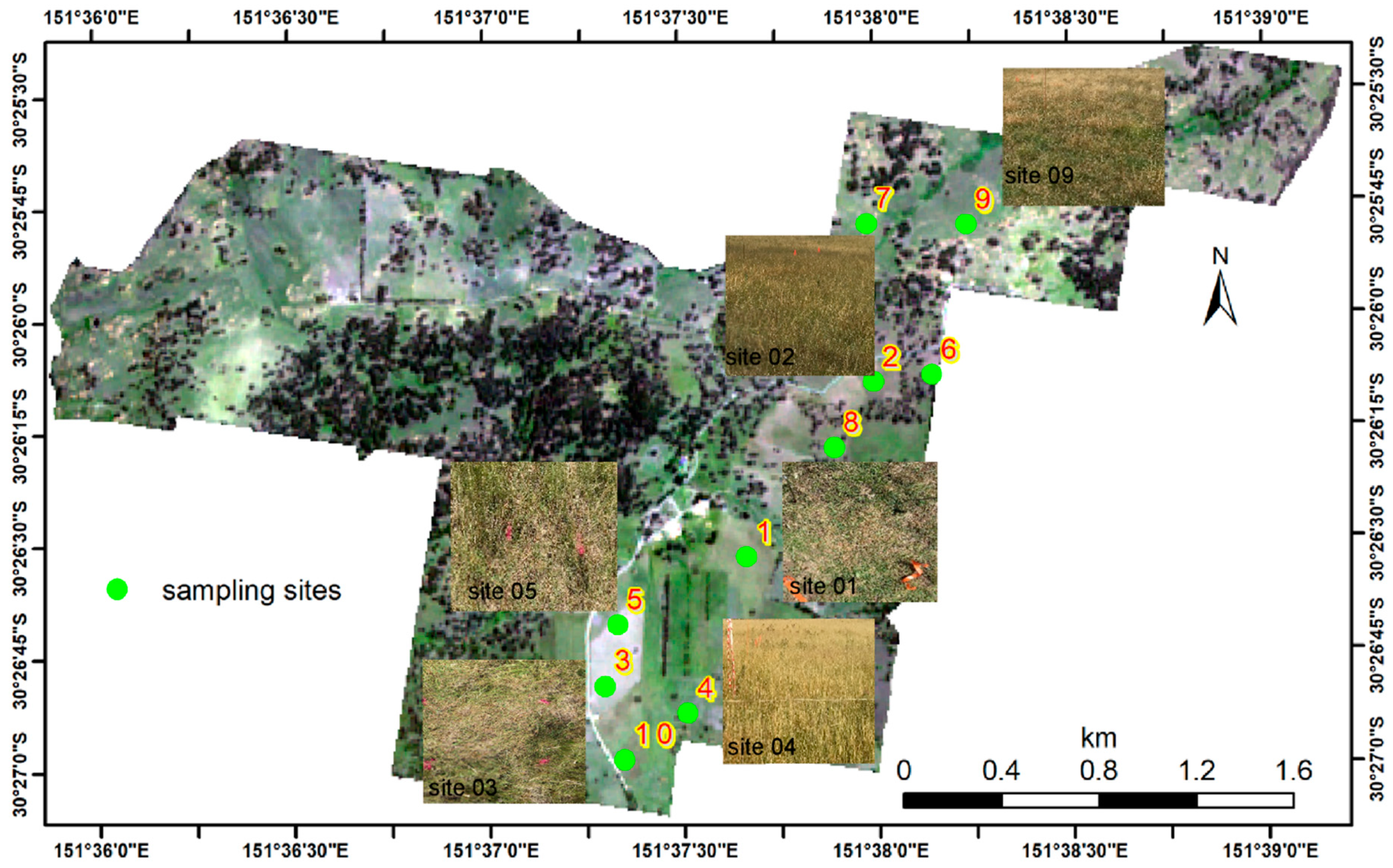
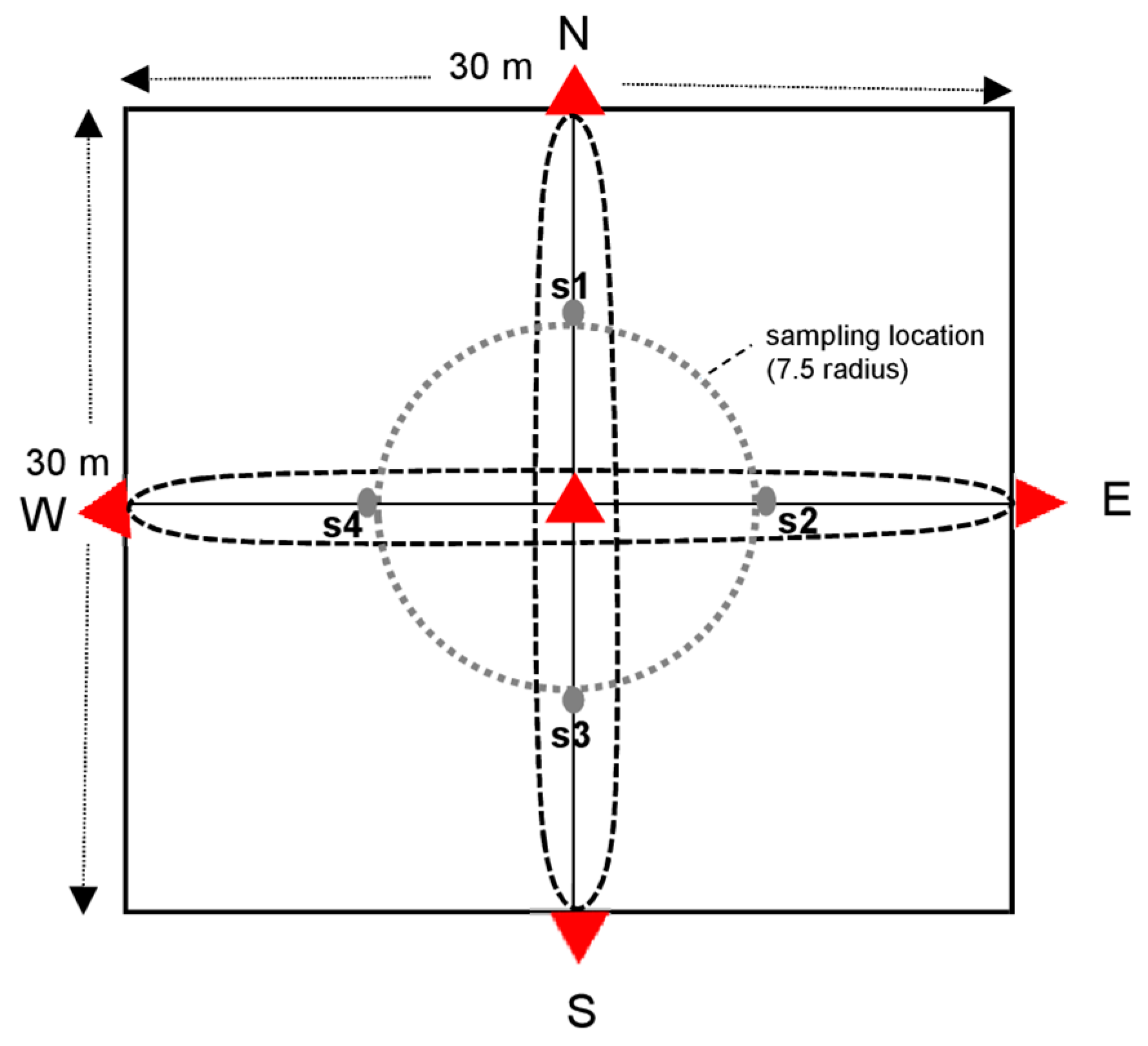


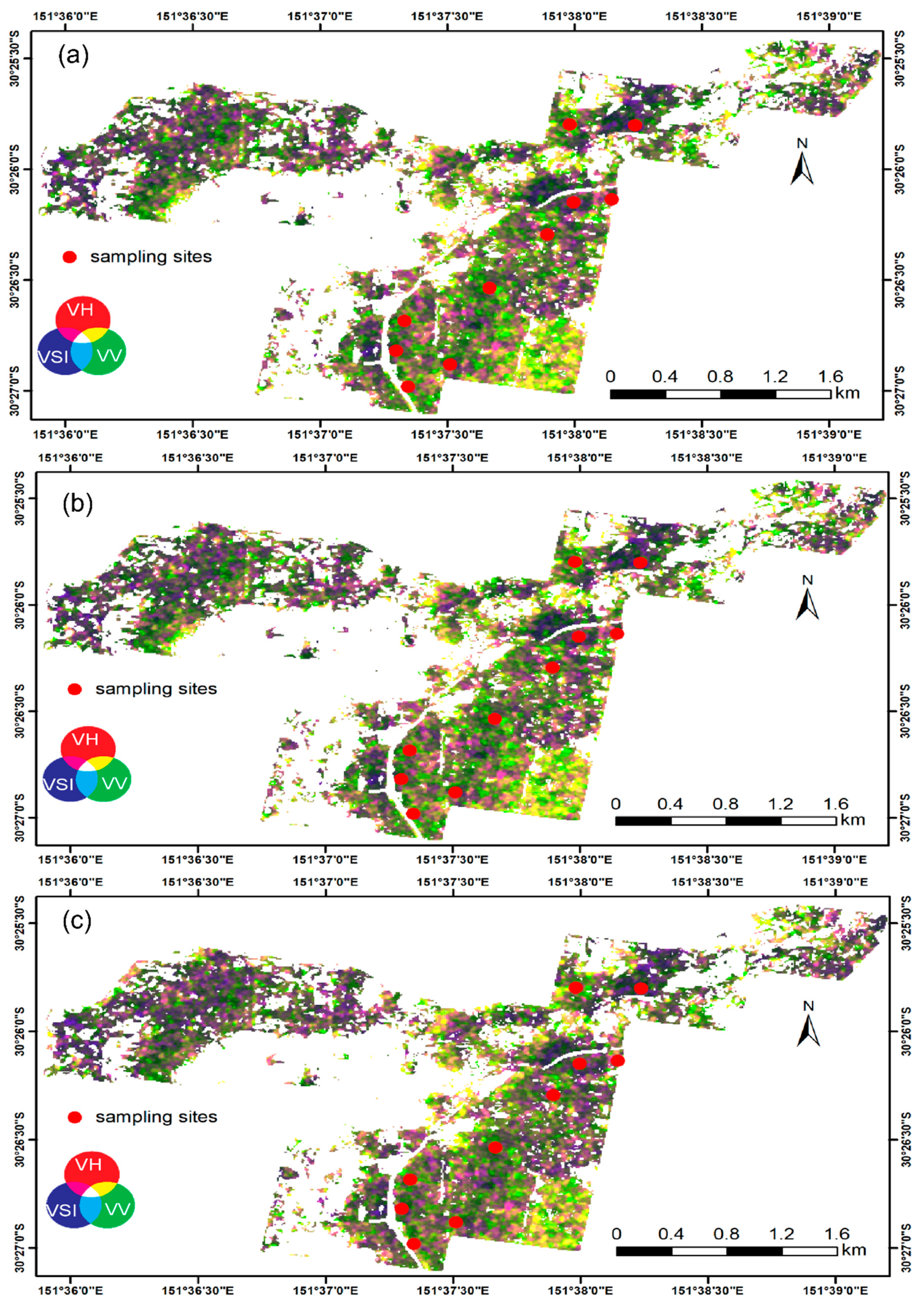
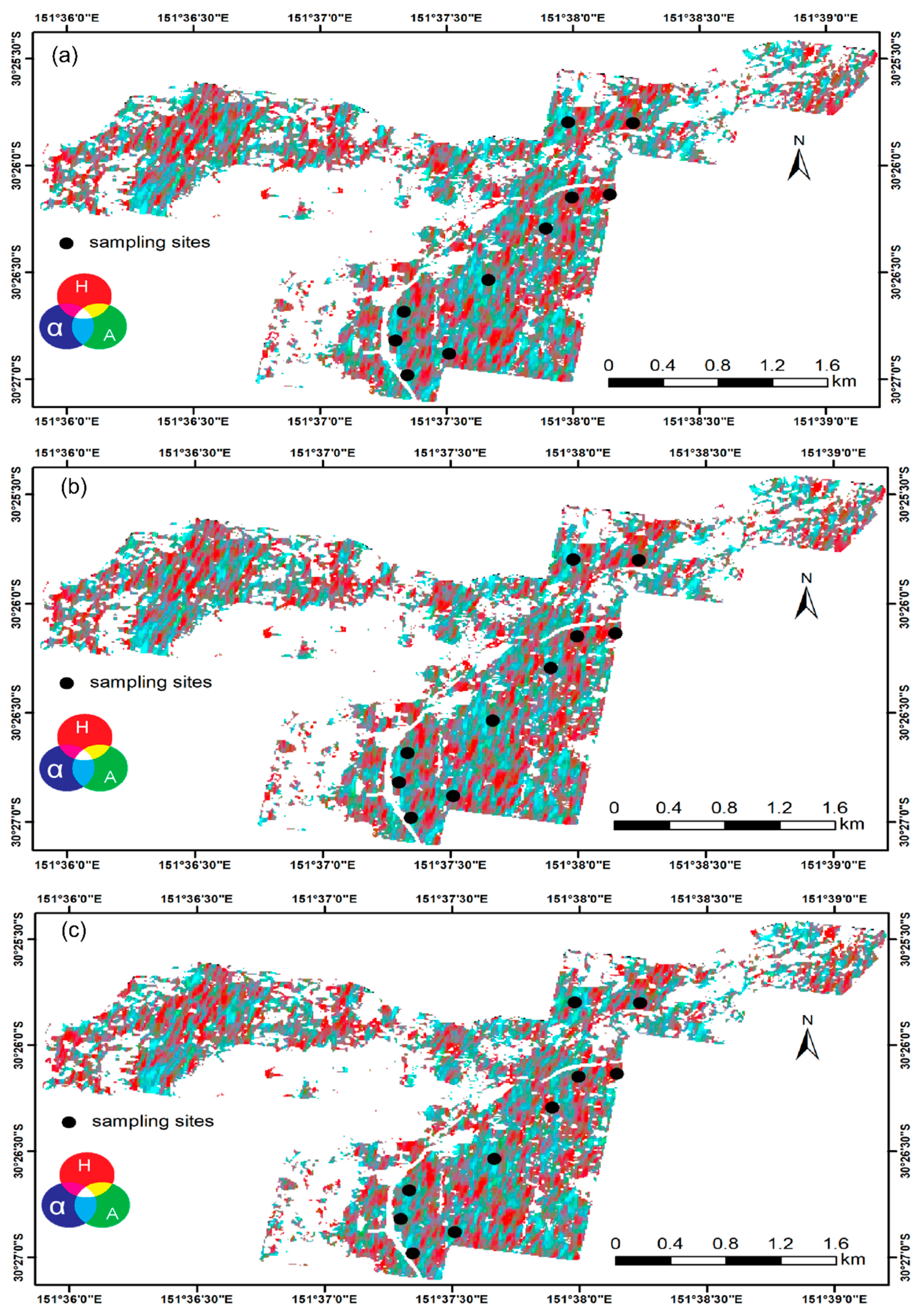

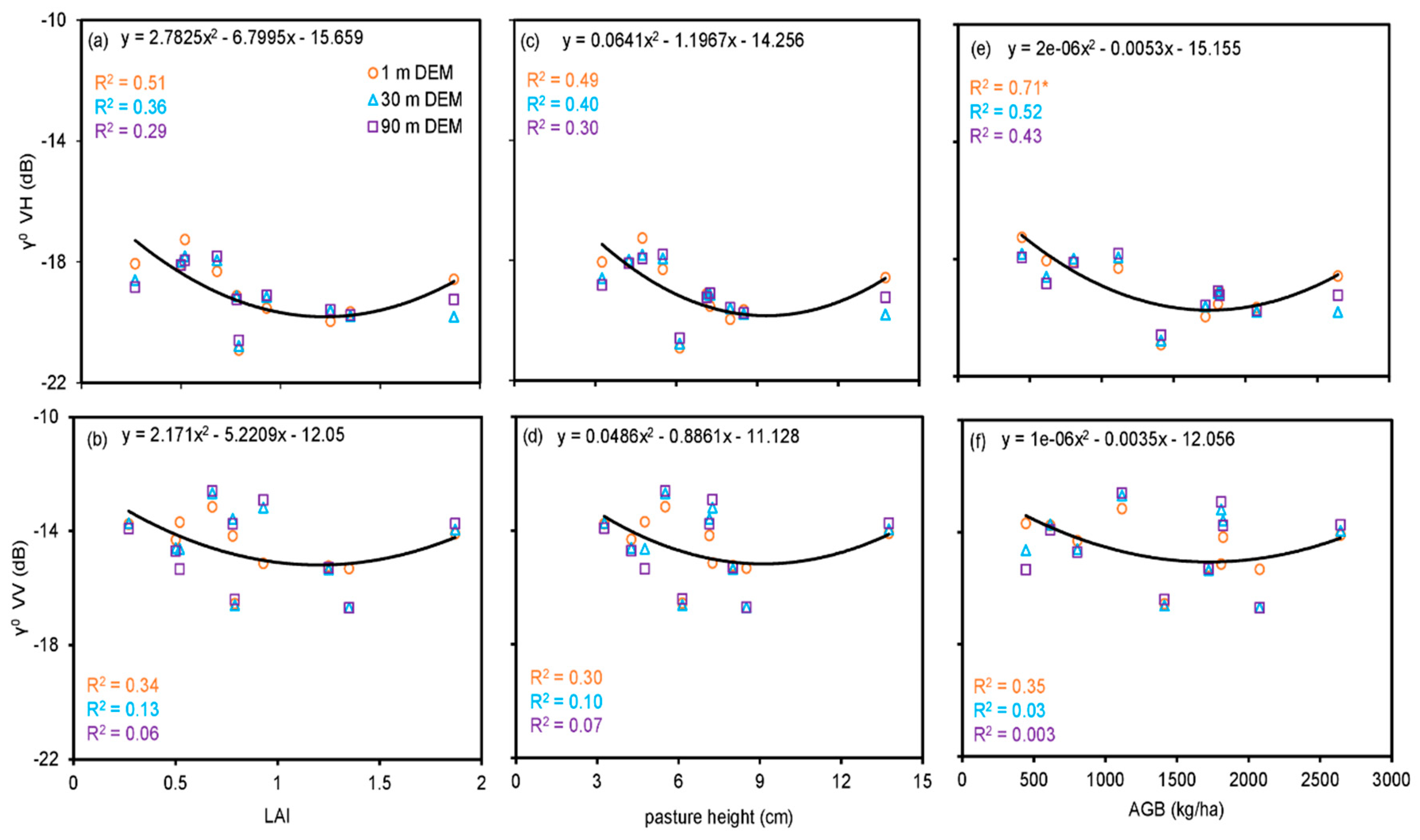
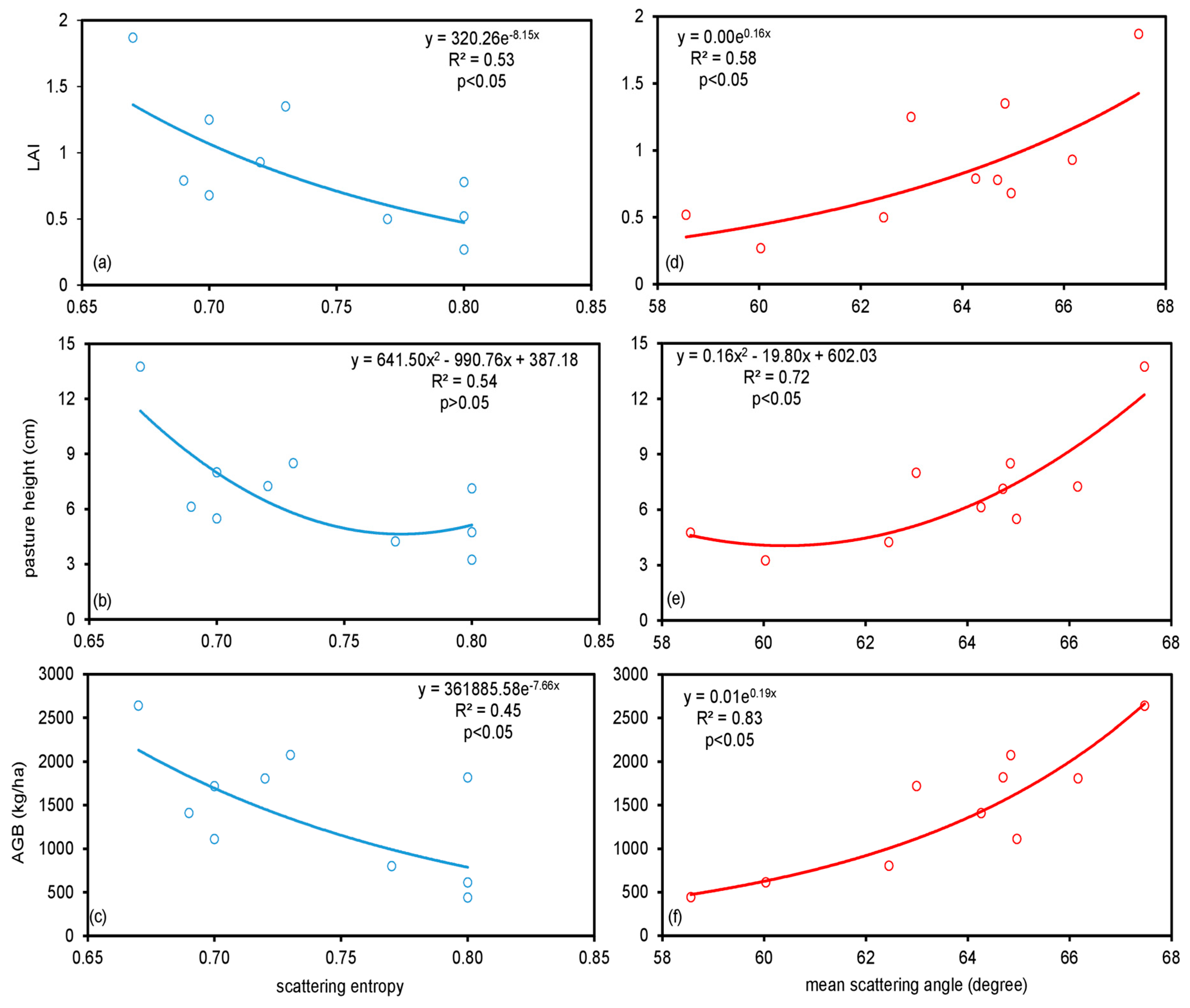
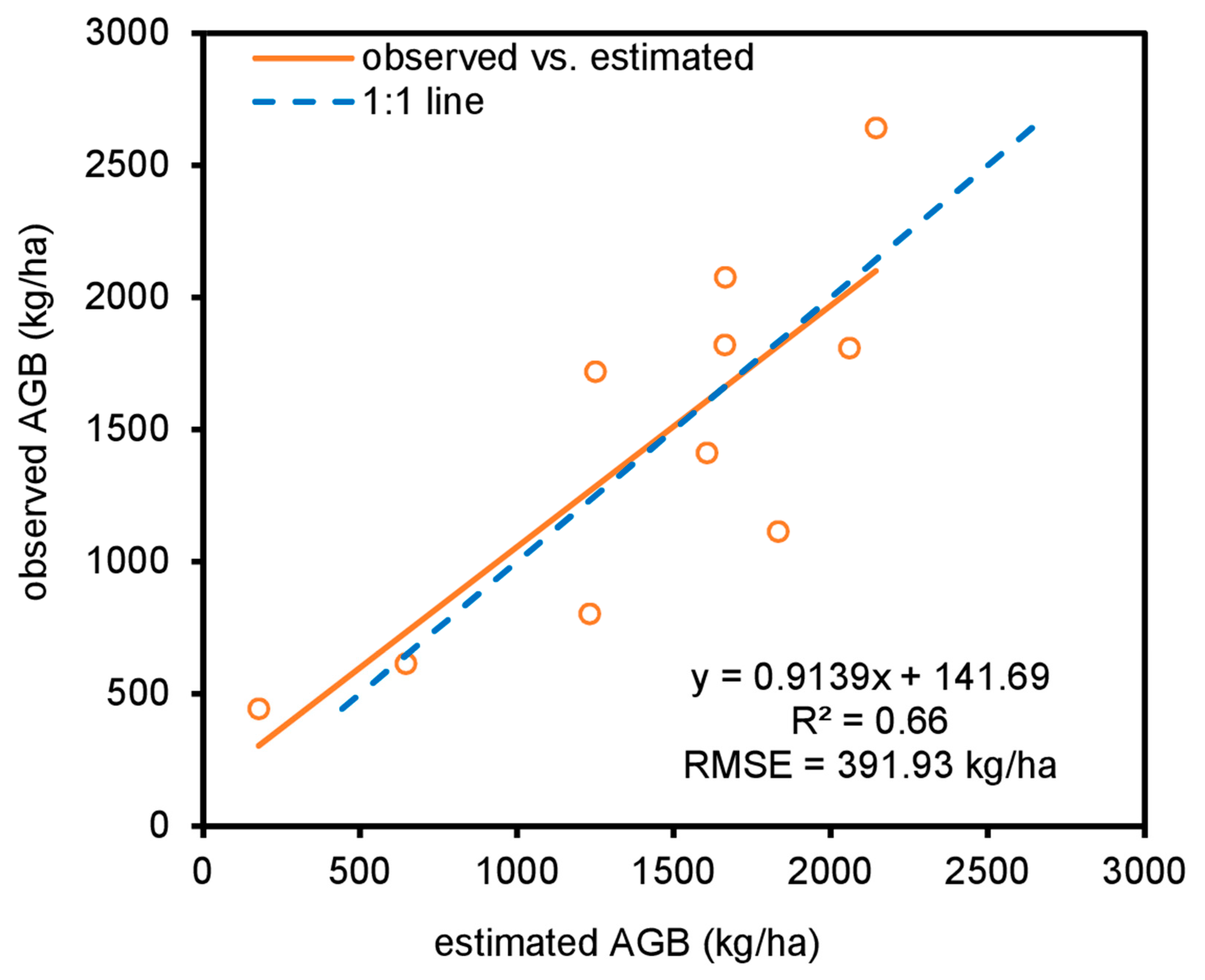
| Feature | Description |
|---|---|
| pass | descending |
| antenna direction | right facing |
| near incidence angle | 36° |
| far incidence angle | 42° |
| azimuth bandwidth | 327 Hz |
| range bandwidth | 56.5 MHz |
| pulse repetition frequency | 1717 Hz |
| pixel spacing (azimuth) | 14.07 m |
| pixel spacing (range) | 3.71 m |
| Model | Coefficient | Estimate | se | p-Value | adj. R2 | edf | Deviance (%) |
|---|---|---|---|---|---|---|---|
| GAM | intercept | 1445.3 | 115.5 | 1.55e-06 | |||
| smooth | 7.96e-04 | 0.73 | 1 | 24.3 | |||
| post-model statistic | |||||||
| Breusch-Pagan | 0.336 | ||||||
© 2019 by the authors. Licensee MDPI, Basel, Switzerland. This article is an open access article distributed under the terms and conditions of the Creative Commons Attribution (CC BY) license (http://creativecommons.org/licenses/by/4.0/).
Share and Cite
Crabbe, R.A.; Lamb, D.W.; Edwards, C.; Andersson, K.; Schneider, D. A Preliminary Investigation of the Potential of Sentinel-1 Radar to Estimate Pasture Biomass in a Grazed Pasture Landscape. Remote Sens. 2019, 11, 872. https://doi.org/10.3390/rs11070872
Crabbe RA, Lamb DW, Edwards C, Andersson K, Schneider D. A Preliminary Investigation of the Potential of Sentinel-1 Radar to Estimate Pasture Biomass in a Grazed Pasture Landscape. Remote Sensing. 2019; 11(7):872. https://doi.org/10.3390/rs11070872
Chicago/Turabian StyleCrabbe, Richard Azu, David William Lamb, Clare Edwards, Karl Andersson, and Derek Schneider. 2019. "A Preliminary Investigation of the Potential of Sentinel-1 Radar to Estimate Pasture Biomass in a Grazed Pasture Landscape" Remote Sensing 11, no. 7: 872. https://doi.org/10.3390/rs11070872
APA StyleCrabbe, R. A., Lamb, D. W., Edwards, C., Andersson, K., & Schneider, D. (2019). A Preliminary Investigation of the Potential of Sentinel-1 Radar to Estimate Pasture Biomass in a Grazed Pasture Landscape. Remote Sensing, 11(7), 872. https://doi.org/10.3390/rs11070872




